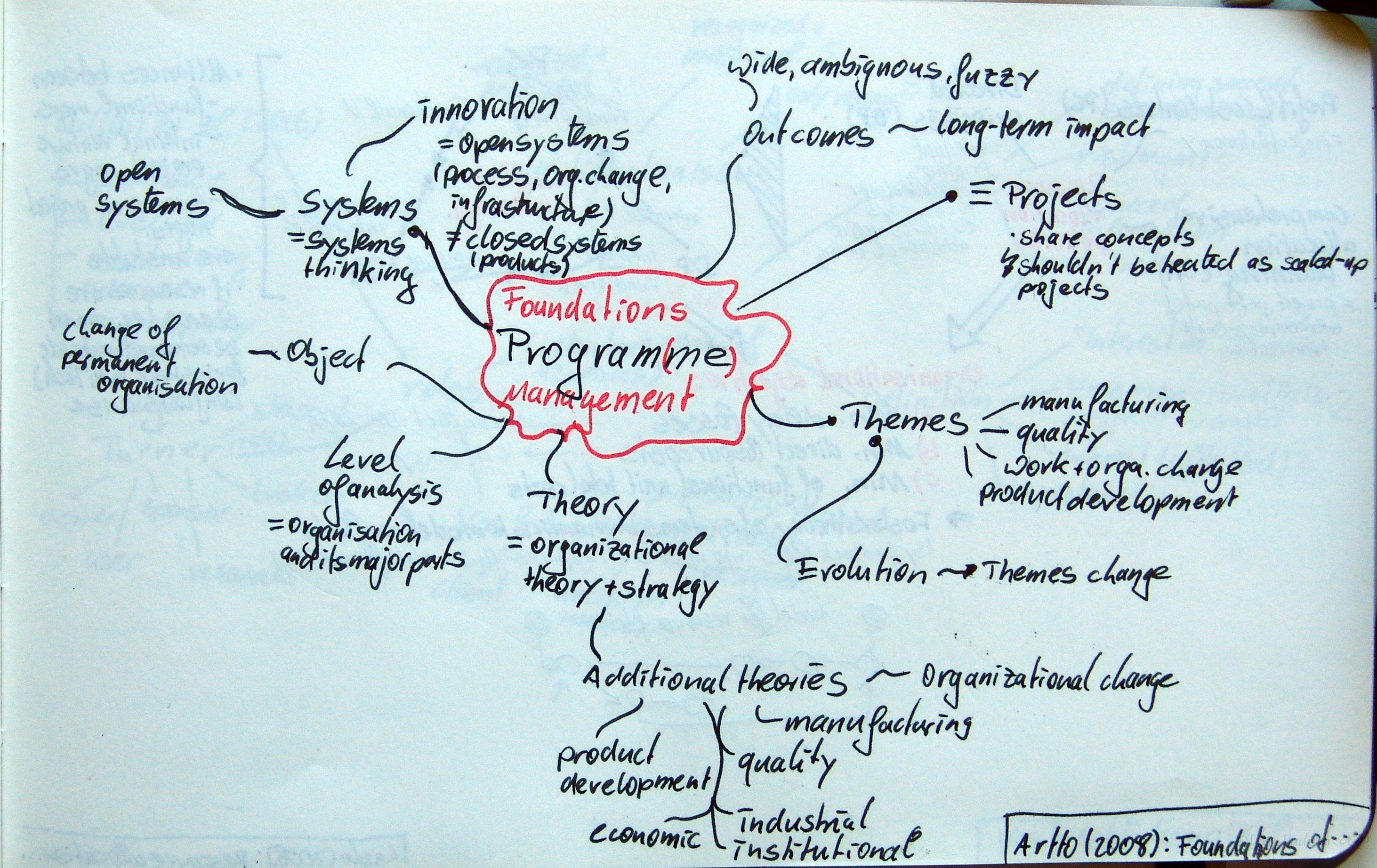 Artto, Karlos; Martinsuo, Miia; Gemünden, Hans Georg; Murtoaro, Jarkko: Foundations of program management – A bibliometric view; in: International Journal of Project Management, Article in Press, Corrected Proofhttp://dx.doi.org/10.1016/j.ijproman.2007.10.007Update: The article has been published in International Journal of Project Management, Vol. 27 (2009), No. 1, pp. 118. Artto et al. investigate the big question if programme management is much more than project management on a large scale. The authors review 517 programme management articles, 1164 project management articles from 21 years. They look into the various foundations of programme management research such as the level of analysis (organisation and its major parts), object of analysis (change of permanent organisation), outcomes of programmes (ambiguity & long-term impacts). Artto et al. also conclude that programmes might be similar to projects, that both management practices share common concepts, but that programmes should not be treated as scaled-up projects.Some more detail is provided regarding the themes, theories, and system thinking behind programme management. The themes, which the authors identified in the literature, are the origins of programme management. They find that programme management has its roots in manufacturing, quality, work and organisational change, and product development. Moreover they do assess the change of focus in these themes – whereas the organisational change is dominant for programmes and new product development is the dominant theme for project management.What is the specific systems thinking regarding programmes? Programmes are usually conceptualised as open systems. [An approach more and more followed in project management research as well.] Furthermore innovation is a major concern of programmes. As such open systems are typically used to innovate processes, organisations, and infrastructure. In contrast innovation using closed systems is more dominant in product development, which subsequently employs more projects than programmes to innovate.Moreover the authors explore the theoretical basis of programme management. They found this research deeply rooted in organisational and strategy theories. Additional theories used to explore this concepts are product development, organisational change, manufacturing, quality, economic, industrial, and institutional theories.Lastly, Artto et al. identify shortcomings of existing research on programme management, which are
Artto, Karlos; Martinsuo, Miia; Gemünden, Hans Georg; Murtoaro, Jarkko: Foundations of program management – A bibliometric view; in: International Journal of Project Management, Article in Press, Corrected Proofhttp://dx.doi.org/10.1016/j.ijproman.2007.10.007Update: The article has been published in International Journal of Project Management, Vol. 27 (2009), No. 1, pp. 118. Artto et al. investigate the big question if programme management is much more than project management on a large scale. The authors review 517 programme management articles, 1164 project management articles from 21 years. They look into the various foundations of programme management research such as the level of analysis (organisation and its major parts), object of analysis (change of permanent organisation), outcomes of programmes (ambiguity & long-term impacts). Artto et al. also conclude that programmes might be similar to projects, that both management practices share common concepts, but that programmes should not be treated as scaled-up projects.Some more detail is provided regarding the themes, theories, and system thinking behind programme management. The themes, which the authors identified in the literature, are the origins of programme management. They find that programme management has its roots in manufacturing, quality, work and organisational change, and product development. Moreover they do assess the change of focus in these themes – whereas the organisational change is dominant for programmes and new product development is the dominant theme for project management.What is the specific systems thinking regarding programmes? Programmes are usually conceptualised as open systems. [An approach more and more followed in project management research as well.] Furthermore innovation is a major concern of programmes. As such open systems are typically used to innovate processes, organisations, and infrastructure. In contrast innovation using closed systems is more dominant in product development, which subsequently employs more projects than programmes to innovate.Moreover the authors explore the theoretical basis of programme management. They found this research deeply rooted in organisational and strategy theories. Additional theories used to explore this concepts are product development, organisational change, manufacturing, quality, economic, industrial, and institutional theories.Lastly, Artto et al. identify shortcomings of existing research on programme management, which are
- Ignorance of original theoretical roots of program and project management
- Neglect of inter-project coordination
- Neglect of inter-organizational issues and theories
- Limited contingency view
- Lack of industry-specific views
- Neglect of the interplay between the permanent and the temporary organization

